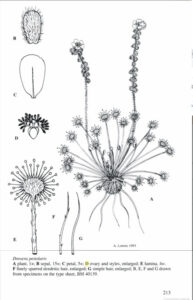Menu
Drosera Petiolaris Information
Purchase Drosera Petiolaris Sundew
Drosera Petiolaris R.BR. ex DC.
Prodr. 1: 318 (1824)
A reddish, tropical, fibrous-rooted perennial plant with a convex, open rosette of many narrow leaves. Stem short, covered with spent leaves, the juvenile leaves generally covered with white hairs, the older petioles almost glabrous with age.
Leaf – lamina suborbicular, 2.5 mm long, 3.5 mm wide, with retentive glands around the  margin and smaller glands within; lower surface covered with long, appressed white hairs, the hairs simple or bearing a few small alternate spurs; petiole linear, 0.4—0.5 mm wide near the base, 0.4—0.8 mm wide for most of the length then narrowed to 0.3-0.5 mm wide at lamina, up to 6 cm long at flowering, both surfaces almost glabrous or with sparse, long, appressed white hairs similar to those on the lower surface of lamina.
margin and smaller glands within; lower surface covered with long, appressed white hairs, the hairs simple or bearing a few small alternate spurs; petiole linear, 0.4—0.5 mm wide near the base, 0.4—0.8 mm wide for most of the length then narrowed to 0.3-0.5 mm wide at lamina, up to 6 cm long at flowering, both surfaces almost glabrous or with sparse, long, appressed white hairs similar to those on the lower surface of lamina.
Inflorescence | or 2, 15-20 cm long, covered with hairs similar to those on leaves but not oppressed; flowers many in a crowded |-sided raceme; pedicels 1.5 mm long.
Sepals – obovate, 1.6-2 mm long, 0.8 mm wide, hairy.
Petals – pink or white, obovate, 6 mm long, 3.5 mm wide.
Stamens – 5, 3 mm long; filaments white; anthers and pollen yellow.
Ovary – pale-green, turbinate, 0.8 mm long, | mm diam.
Styles – 3, 2 mm long, each divided into a small number of dilated segments; stigmas covering the surface of each dilated segment.
FLOWERING: October—April. Dormancy dry.
Habitat: Grows in the sand near creeks and pools in sedge land, often standing in shallow water during the wet season.
LOCATION: Qld—Endeavour River, Brown Creek; N.T.—Noonamah, Howard Springs.
The type of Drosera petiolaris is a collection by Banks and Solander made during the Cook expedition in 1770 at the Endeavour River in northern Queensland. Examination of the type material, kindly loaned by the British Museum, revealed the fine details of the species that distinguish it from the vast array of tropical taxa in the D. petiolaris complex. The type has narrow petioles 0.4—0.8 mm wide and up to 6 cm long; a suborbicular lamina 2.5 mm long, 3.5 wide with a covering of appressed hairs on both surfaces of the petiole and abaxial surface of the lamina; obovate sepals 1.6—2 mm long and 0.8 mm wide with the abaxial surface covered with the same hairs as those on the leaves; pedicels 1.5 mm long. The hairs are of two types, a simple hair and a simple hair bearing a few, fine, very short, alternate spurs. Although the type lacks flower parts other than sepals, sufficient information was gained to establish the principal morphological characteristics of D. petiolaris.
Narrow-leaved specimens from the Northern Territory attributed to this species are vegetatively comparable to those found in Queensland. The inflorescence differs in having pedicels up to 8 mm long. The type of D. petiolaris has pedicels 1.5 mm long.
Menu
